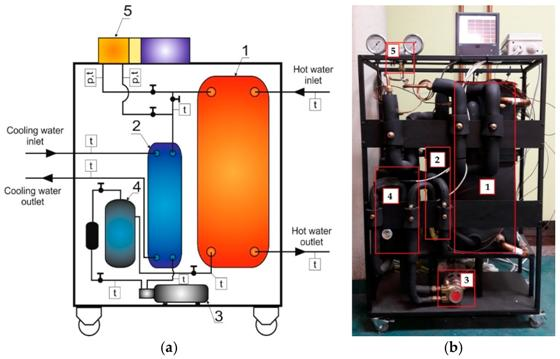Experimental and Numerical Analyses on the Rotary Vane Expander Operating Conditions in a Micro Organic Rankine Cycle System
Abstract
:1. Introduction
2. Description of the Experimental Test-Stand and the Experiment Results
2.1. Description of the Test-Stand and the Multi-Vane Expander
2.2. The Experimental Description and Results
3. Numerical Modelling
3.1. The Governing Equations
3.2. The Computational Grid
3.3. Model Details
4. Results and Discussion
5. Summary and Conclusions
Acknowledgments
Author Contributions
Conflicts of Interest
References
- Asif, M.; Muneer, T. Energy supply, its demand and security issues for developed and emerging economies. Renew. Sustain. Energy Rev. 2007, 11, 1388–1413. [Google Scholar] [CrossRef]
- Meij, R. Trace element behavior in coal-fired power plants. Fuel Process. Technol. 1994, 39, 199–217. [Google Scholar] [CrossRef]
- Dinusha Rathnayaka, A.J.; Potdar, V.M.; Dillon, T.S.; Kuruppu, S. Formation of virtual community groups to manage prosumers in smart grids. Int. J. Grid Util. Comput. 2015, 6, 47–56. [Google Scholar] [CrossRef]
- Lund, H. Renewable Energy Systems, 2nd ed.; Academic Press: Manhattan, NY, USA, 2014. [Google Scholar]
- Neville, R.C. Solar Energy Conversion, 2nd ed.; Elsevier: Amsterdam, The Netherlands, 1995. [Google Scholar]
- Hau, E. Wind Turbines—Fundamentals, Technologies, Application, Economics; Springer: Berlin, Germany, 2013. [Google Scholar]
- Saidur, R.; Abdelaziz, E.A.; Demirbas, A.; Hossain, M.S.; Mekhilef, S. A review on biomass as a fuel for boilers. Renew. Sustain. Energy Rev. 2011, 15, 2262–2289. [Google Scholar] [CrossRef]
- Revankar, S.T.; Majumdar, P. Fuel Cells: Principles, Design, and Analysis; CRC Press: Boca Raton, FL, USA, 2014. [Google Scholar]
- Dinçer, I.; Rosen, M.A. Thermal Energy Storage: Systems and Applications; John Wiley & Sons: Chichester, UK, 2002. [Google Scholar]
- Kolasiński, P. The influence of the heat source temperature on the multivane expander output power in an organic Rankine cylce (ORC) system. Energies 2015, 8, 3351–3369. [Google Scholar] [CrossRef]
- Ahmadi, P.; Dincer, I.; Rosen, M.A. Development and assessment of an integrated biomass-based multi-generation energy system. Energy 2013, 56, 155–166. [Google Scholar] [CrossRef]
- Tchanche, B.F.; Lambrinos, Gr.; Frangoudakis, A.; Papadakis, G. Low-grade heat conversion into power using organic Rankine cycles—A review of various applications. Renew. Sustain. Energy Rev. 2011, 15, 3969–3979. [Google Scholar] [CrossRef]
- Bao, J.; Zhao, L. A review of working fluid and expander selections for organic Rankine cycle. Renew. Sustain. Energy Rev. 2013, 24, 325–342. [Google Scholar] [CrossRef]
- Mago, P.J.; Luck, R. Energetic and exergetic analysis of waste heat recovery from a microturbine using organic Rankine cycles. Int. J. Energy Res. 2013, 37, 888–898. [Google Scholar] [CrossRef]
- Kozanecki, Z.; Łagodziński, J. Magnetic thrust bearing for the ORC high-speed microturbine. Solid State Phenom. 2013, 198, 348–353. [Google Scholar] [CrossRef]
- Liu, H.; Qiu, G.; Shao, Y.; Daminabo, F.; Riffat, S.B. Preliminary experimental investigations of a biomass-fired micro-scale CHP with organic Rankine cycle. Int. J. Low-Carbon Technol. 2010, 5, 81–87. [Google Scholar] [CrossRef]
- Cotana, F.; Messineo, A.; Petrozzi, A.; Coccia, V.; Cavalaglio, G.; Aquino, A. Comparison of ORC turbine and stirling engine to produce emectricity from gasified poultry waste. Sustainability 2014, 6, 5714–5729. [Google Scholar] [CrossRef]
- Kozanecki, Z.; Kozanecka, D.; Klonowicz, P.; Łagodziński, J.; Gizelska, M.; Tkacz, E.; Miazga, M.; Kaczmarek, A. Oil-Less Small Power Turbo-Machines; Institute of Fluid-flow Machinery Publishing: Gdańsk, Poland, 2014. [Google Scholar]
- Gnutek, Z.; Kolasiński, P. The application of rotary vane expanders in organic Rankine cycle systems—Thermodynamic description and experimental results. J. Eng. Gas Turbines Power 2013, 135. [Google Scholar] [CrossRef]
- Montenegro, G.; Della Tore, A.; Fiocco, M.; Onorati, A.; Benatzky, C.; Schlager, G. Evaluating the performance of rotary vane expander for small scale organic Rankine cycles using CFD tools. Energy Procedia 2014, 45, 1136–1145. [Google Scholar] [CrossRef]
- Montenegro, G.; Della Tore, A.; Onorati, A.; Broggi, D.; Schlager, G.; Benatzky, C. CFD simulation of a sliding vane expander operating inside a small scale ORC for low temperature waste heat recovery. In Proceedings of the 9th OpenFOAM Workshop, Zagreb, Croatia, 23–26 June 2014. [CrossRef]
- Ansys CFX Theory Guide; ANSYS, Inc.: Canonsburg, PA, USA, 2014.
- Soave, G. Equilibrium constants from a modified Redlich-Kwong equation of state. Chem. Eng. Sci. 1972, 27, 1197–1203. [Google Scholar] [CrossRef]
- Jia, X.; Zhang, B.; Yang, B.; Peng, X. Study of a rotary vane expander for the transcritical CO2 Cycle—Part II: Theoretical modeling. HVACR Res. 2009, 15, 689–709. [Google Scholar] [CrossRef]
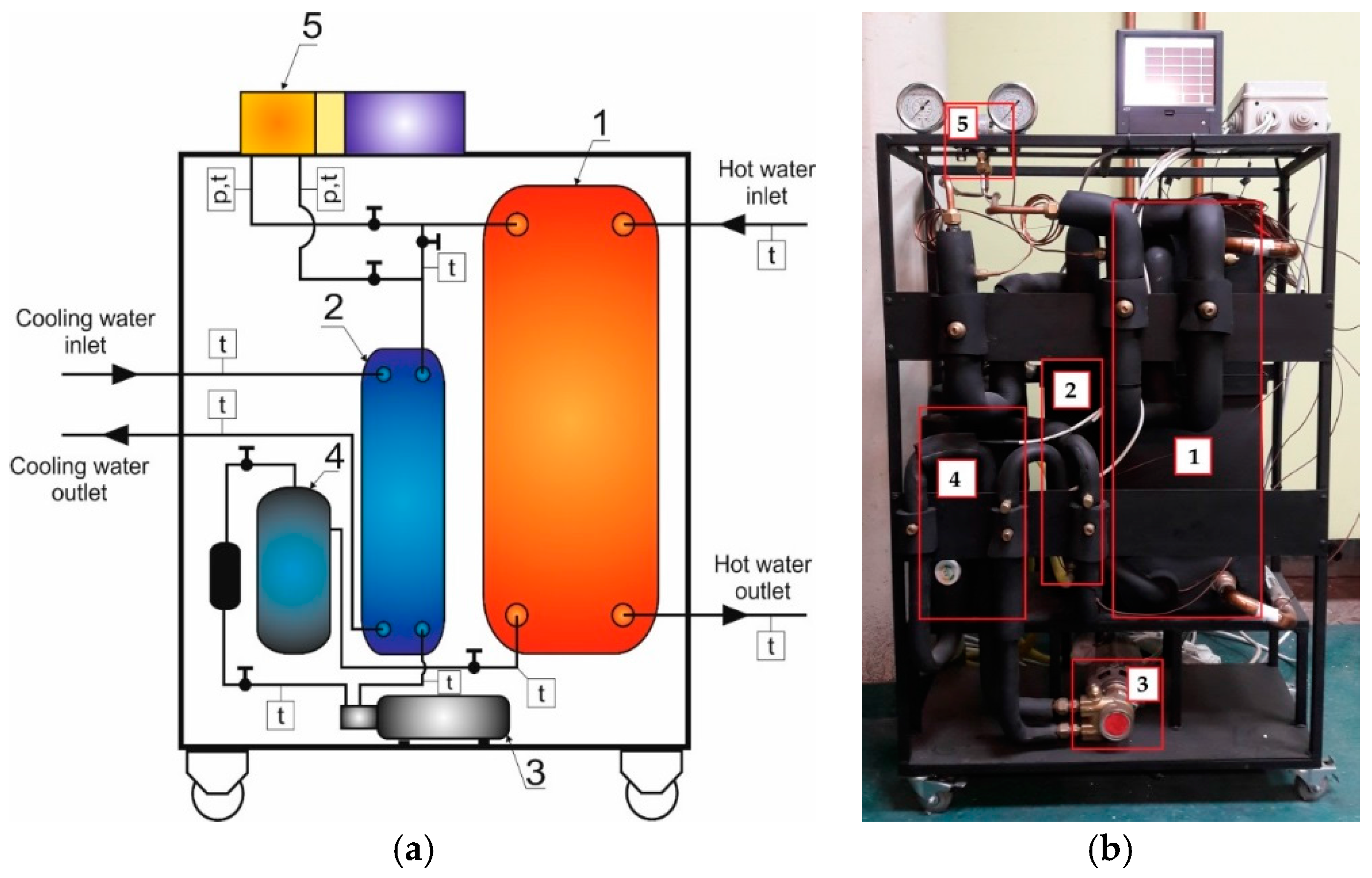

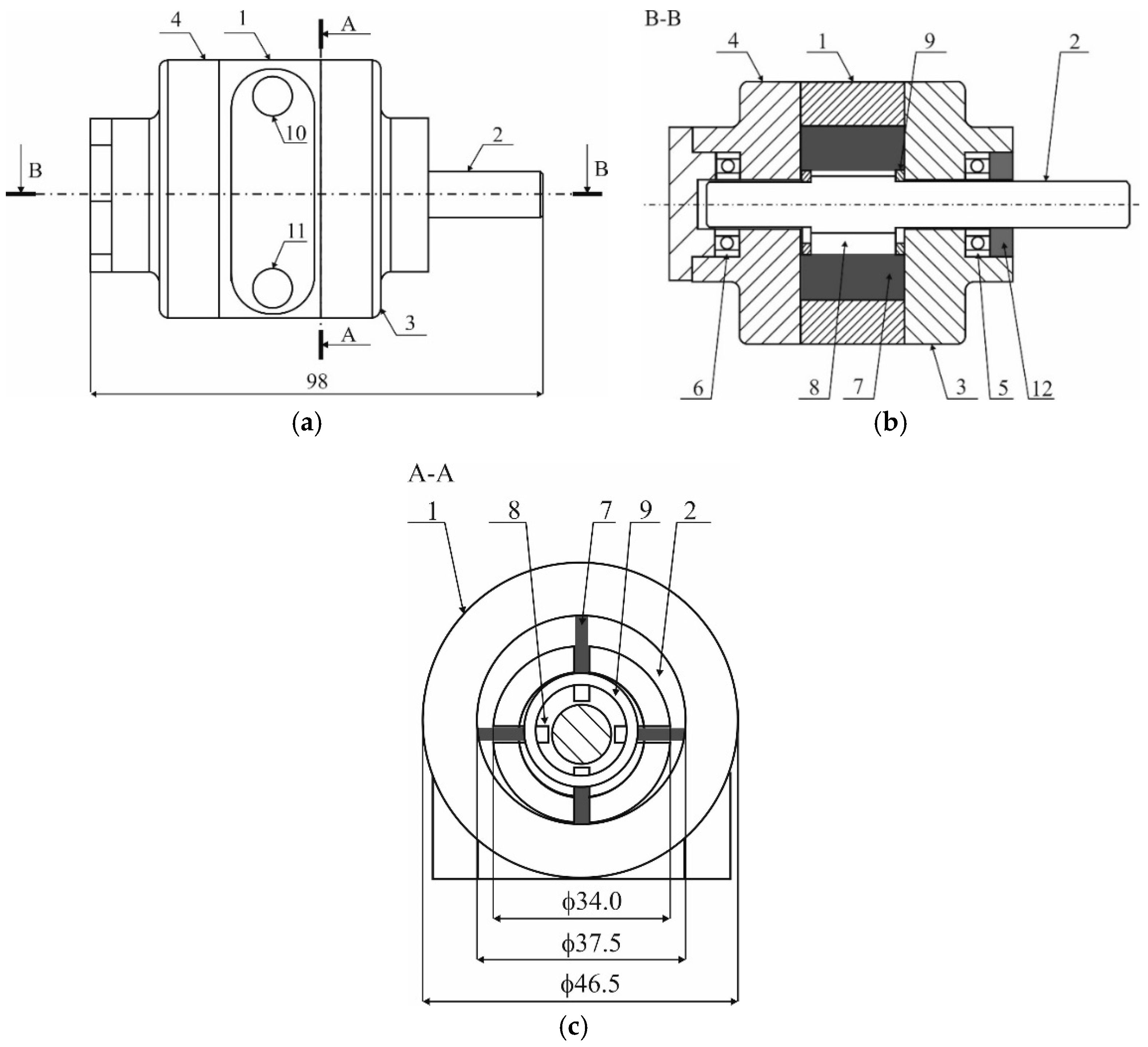
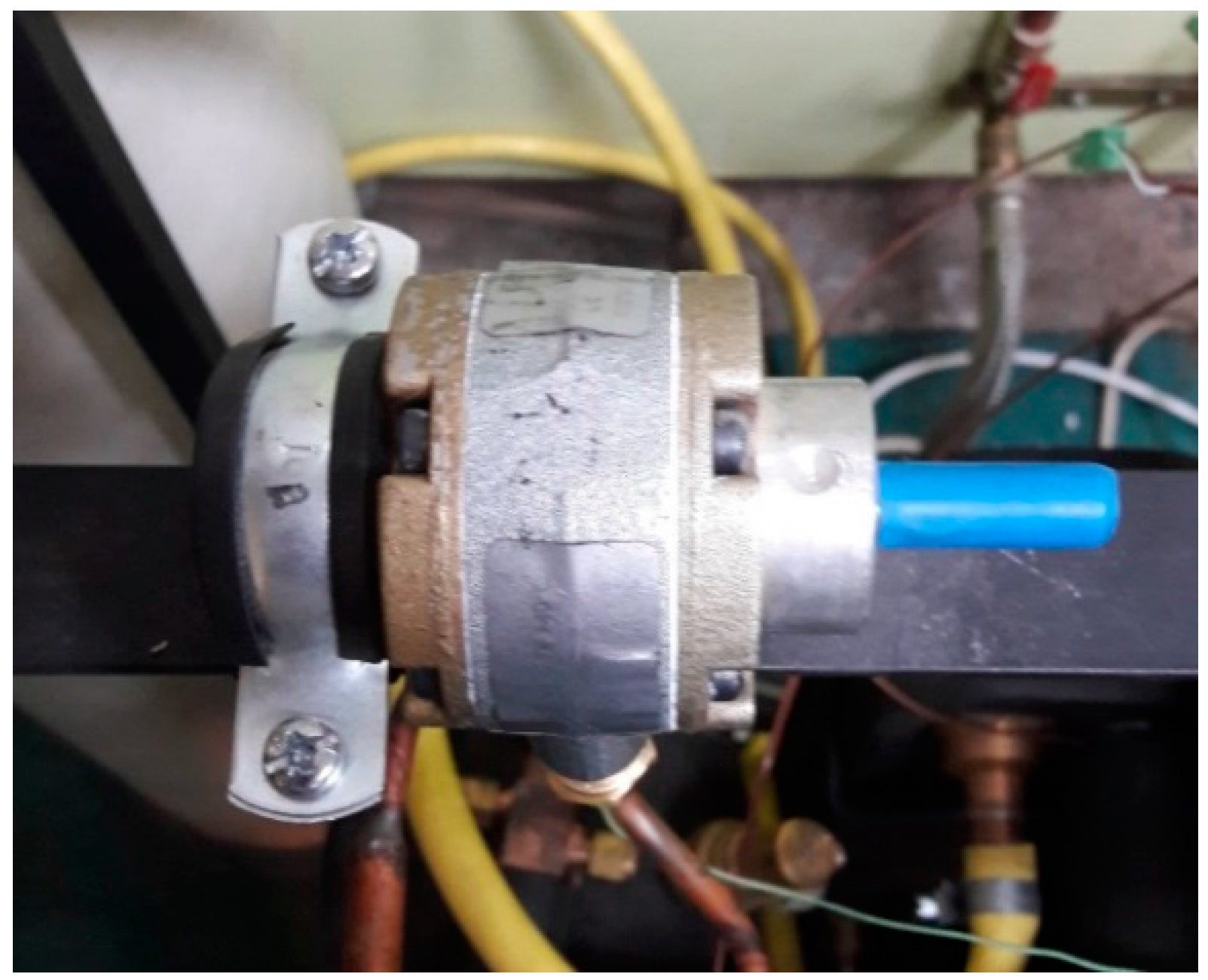

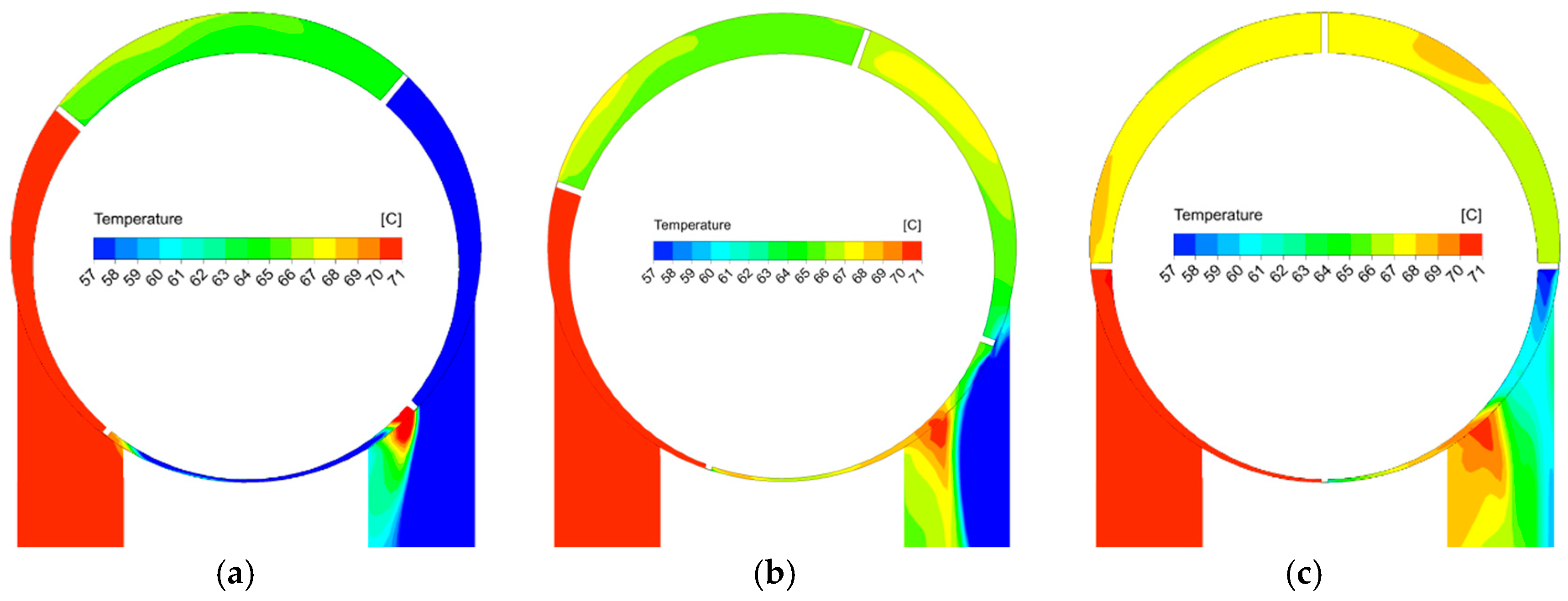
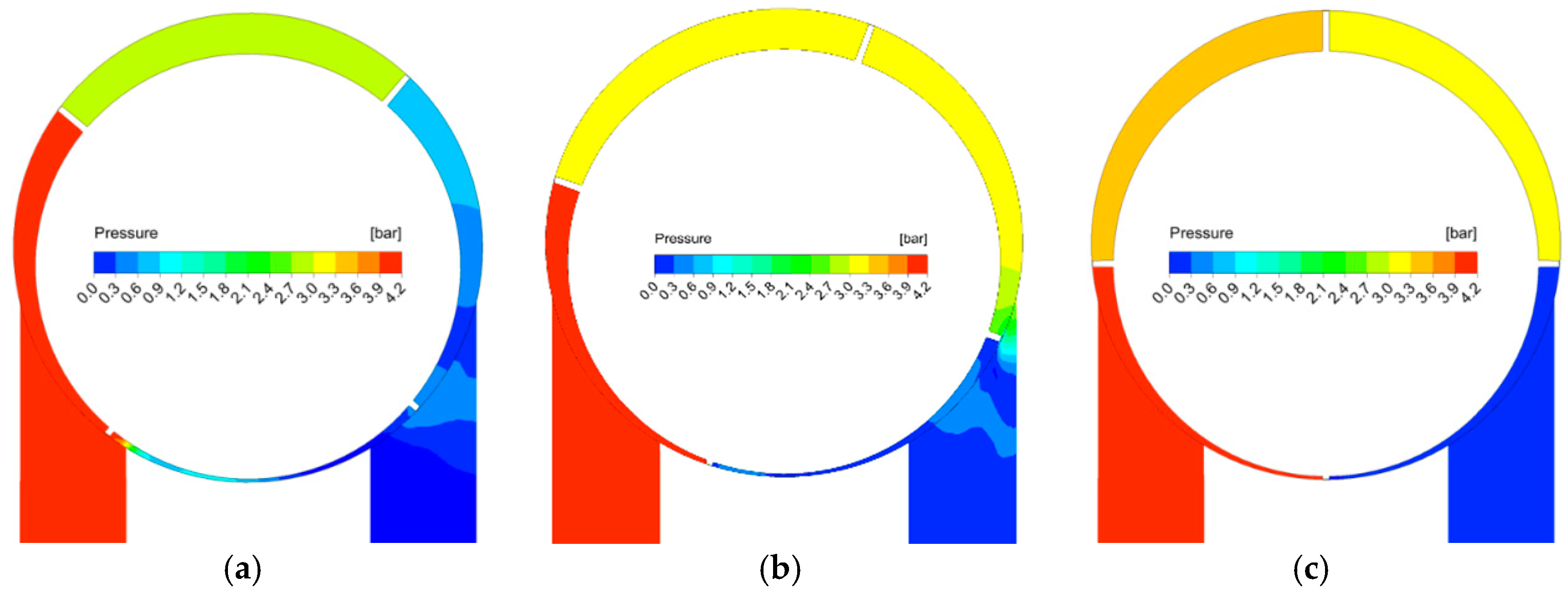
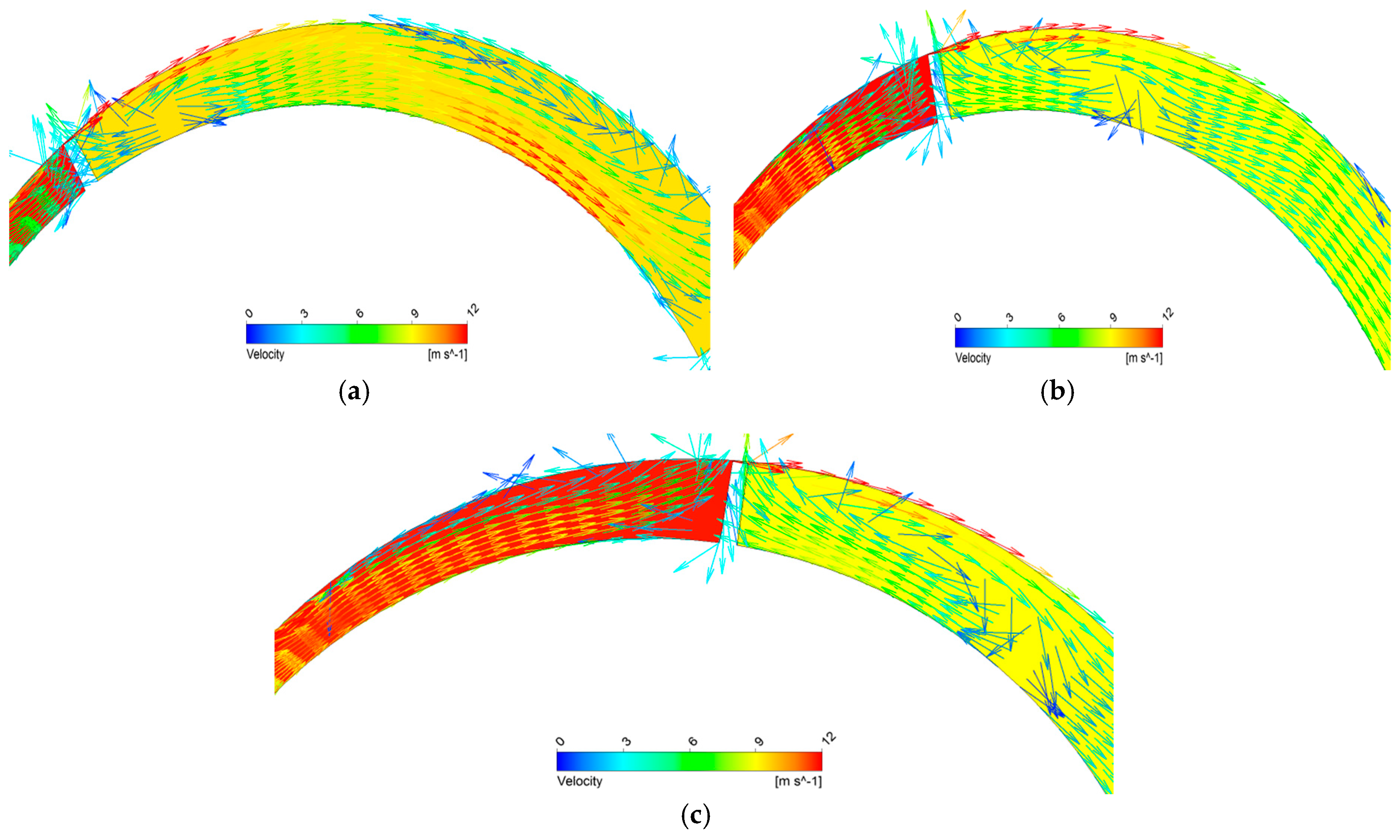
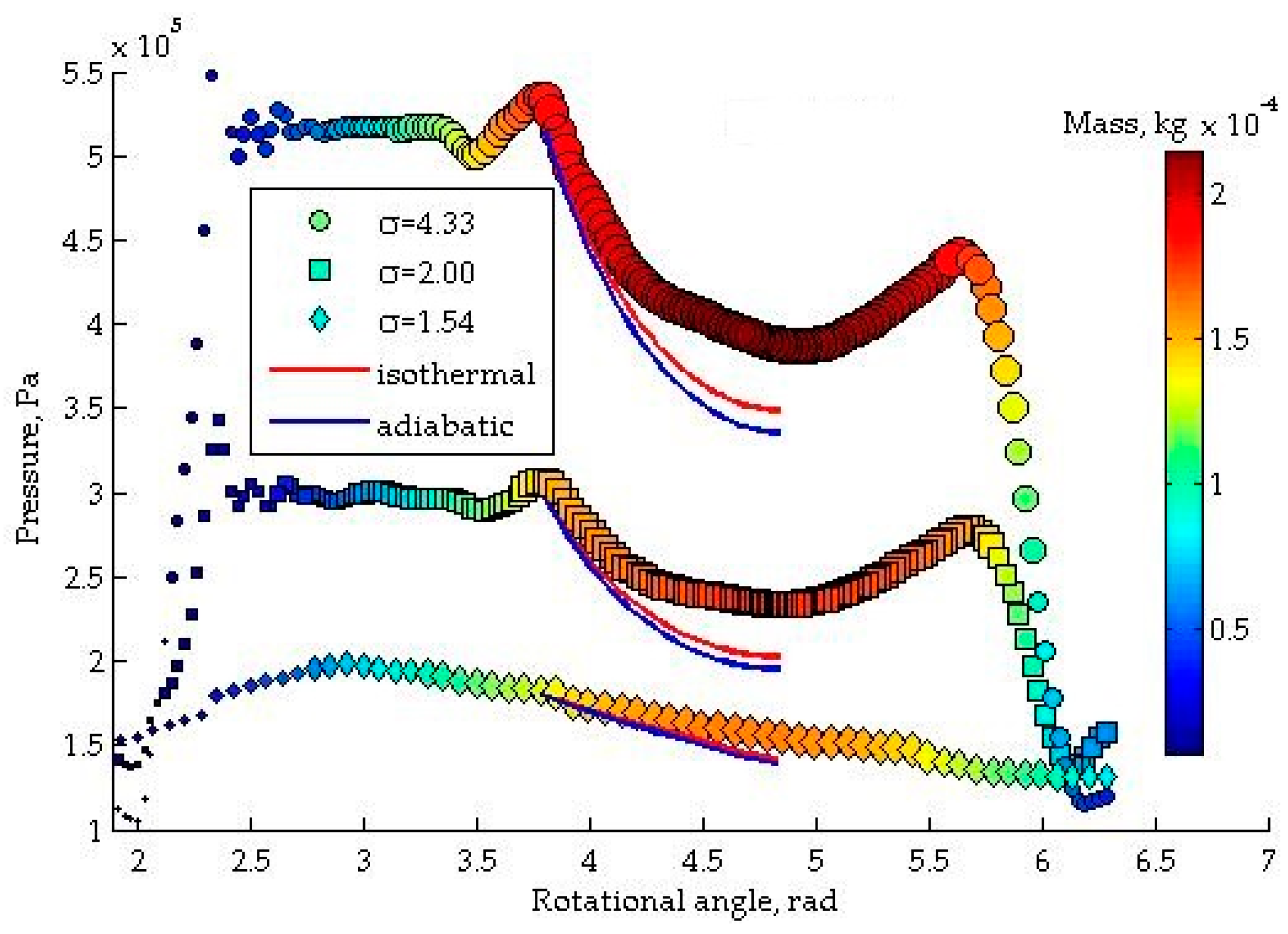
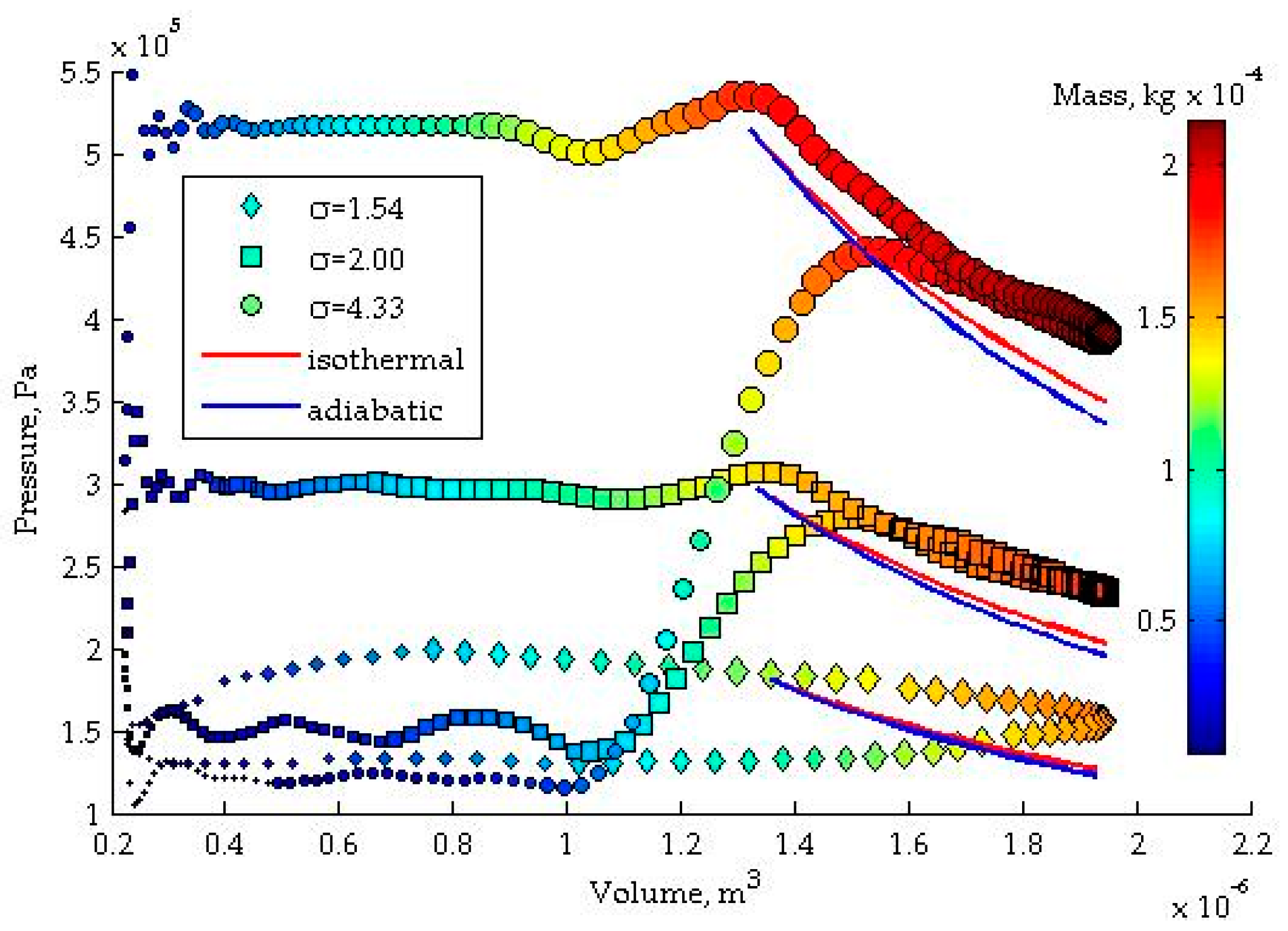
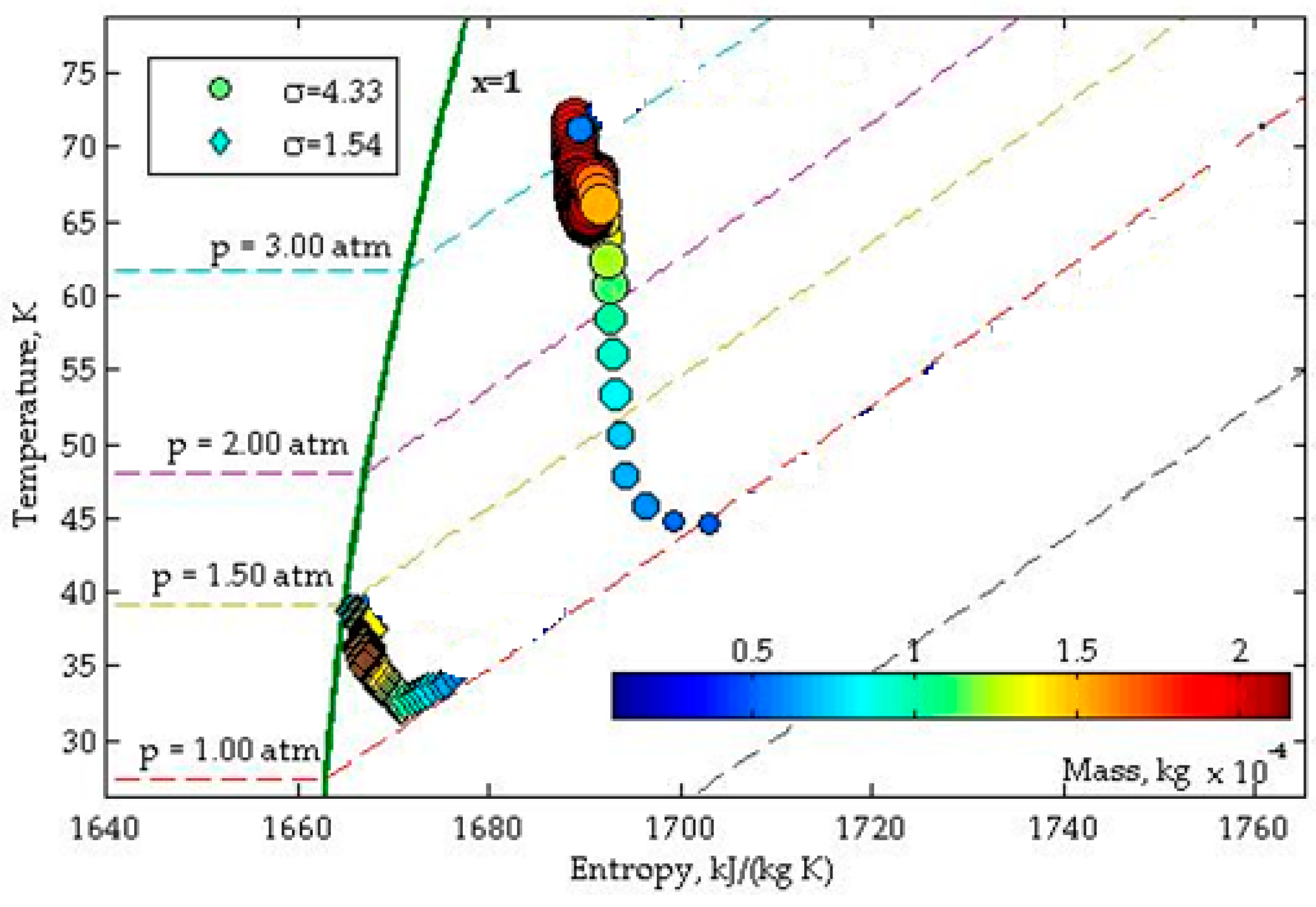
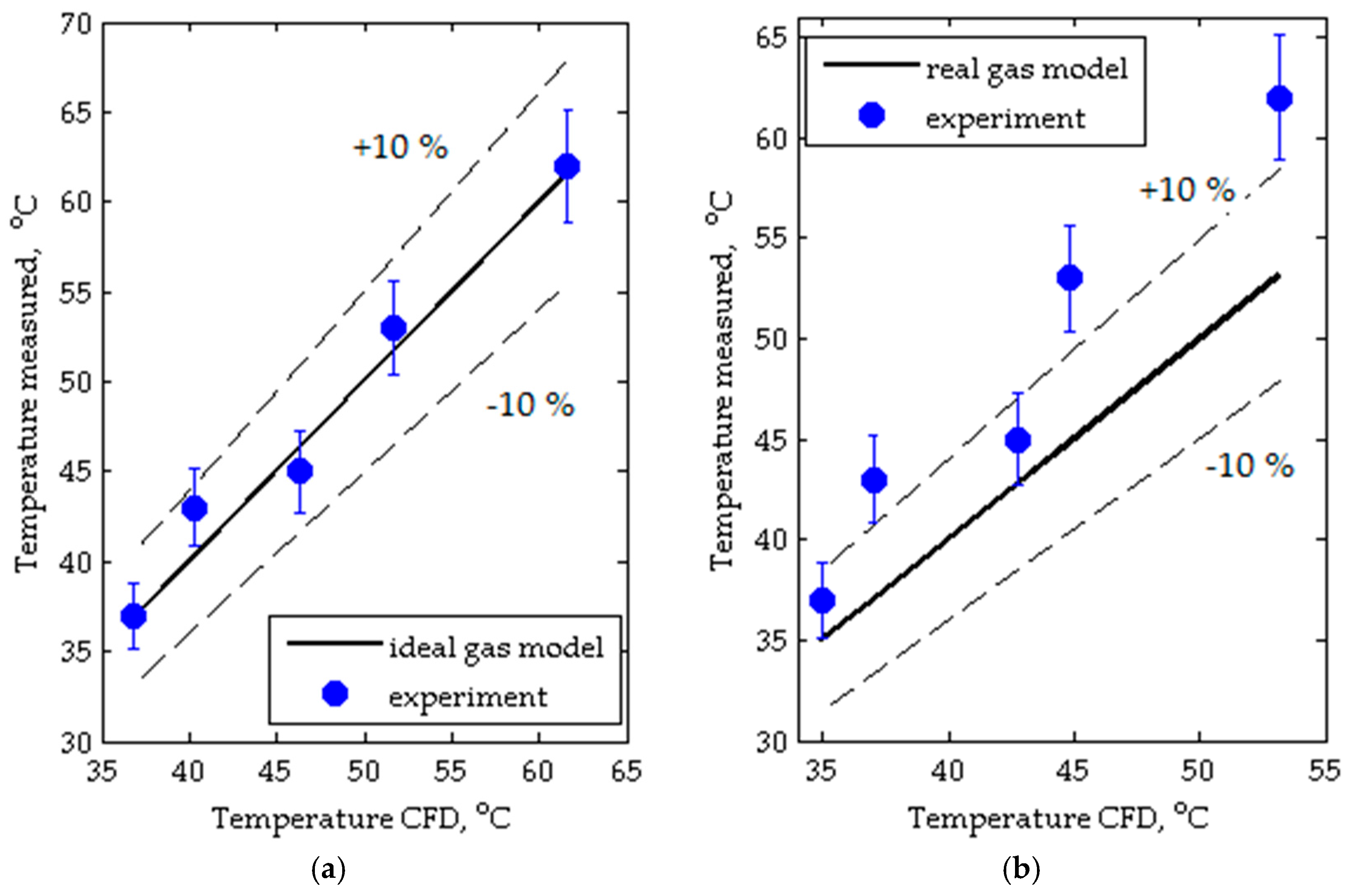
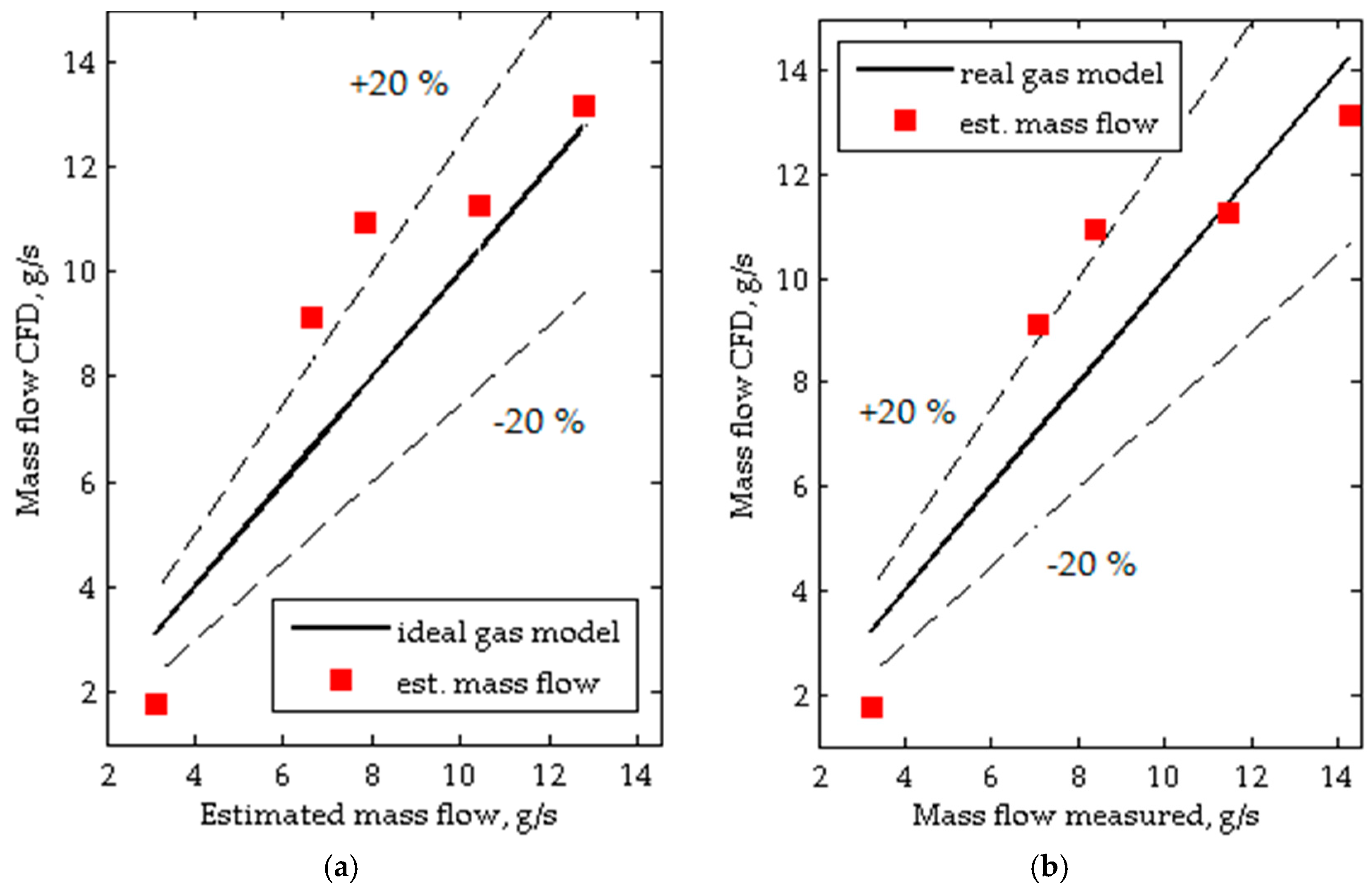
| No. | ths (°C) | pin (bar) | tin (°C) | pout (bar) | tout (°C) | n (rev/min) |
|---|---|---|---|---|---|---|
| 1 | 45 | 2.0 | 39.0 | 1.3 | 37.0 | 700 |
| 2 | 55 | 2.5 | 46.0 | 1.2 | 37.0 | 3280 |
| 3 | 65 | 3.0 | 52.0 | 1.5 | 45.0 | 3300 |
| 4 | 75 | 4.2 | 60.0 | 1.2 | 53.0 | 2900 |
| 5 | 85 | 5.2 | 71.0 | 1.2 | 62.0 | 2950 |
| No. | σ | hin | sin | hout | hout s | sout | ls | li | ηi |
|---|---|---|---|---|---|---|---|---|---|
| kJ/kg | kJ/kgK | kJ/kg | kJ/kg | kJ/kgK | kJ/kg | kJ/kg | (-) | ||
| 1 | 1.54 | 404.94 | 1.665 | 403.98 | 402.71 | 1.669 | 2.22 | 0.96 | 0.431 |
| 2 | 2.08 | 409.12 | 1.666 | 404.94 | 401.95 | 1.676 | 7.17 | 4.18 | 0.583 |
| 3 | 2.00 | 412.69 | 1.668 | 408.91 | 406.04 | 1.677 | 6.64 | 3.78 | 0.569 |
| 4 | 3.50 | 417.4 | 1.671 | 413.92 | 403.25 | 1.704 | 14.15 | 3.47 | 0.246 |
| 5 | 4.33 | 423.8 | 1.675 | 420.47 | 404.47 | 1.724 | 19.33 | 3.32 | 0.172 |
| Parameter | Value | Remarks |
|---|---|---|
| Properties at the inlet | pin, Tin | From measurements |
| Properties at the outlet | pout | From measurements |
| Rotational speed | n | From measurements |
| Time step | 5.5 × 10−5 s | 1 degree of revolution |
| Total time | 0.1 s | 5 full revolutions |
| Turbulence model | k-epsilon | Standard model |
| Wall heat transfer | Adiabatic | - |
| Vane-to-wall clearance | 40 μm | - |
© 2016 by the authors; licensee MDPI, Basel, Switzerland. This article is an open access article distributed under the terms and conditions of the Creative Commons Attribution (CC-BY) license (http://creativecommons.org/licenses/by/4.0/).
Share and Cite
Kolasiński, P.; Błasiak, P.; Rak, J. Experimental and Numerical Analyses on the Rotary Vane Expander Operating Conditions in a Micro Organic Rankine Cycle System. Energies 2016, 9, 606. https://doi.org/10.3390/en9080606
Kolasiński P, Błasiak P, Rak J. Experimental and Numerical Analyses on the Rotary Vane Expander Operating Conditions in a Micro Organic Rankine Cycle System. Energies. 2016; 9(8):606. https://doi.org/10.3390/en9080606
Chicago/Turabian StyleKolasiński, Piotr, Przemysław Błasiak, and Józef Rak. 2016. "Experimental and Numerical Analyses on the Rotary Vane Expander Operating Conditions in a Micro Organic Rankine Cycle System" Energies 9, no. 8: 606. https://doi.org/10.3390/en9080606




